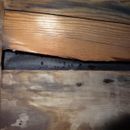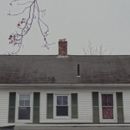Moisture above roof sheathing
We just removed some very old insulation from between the rafters of our attic ceiling. Between the sheathing boards there is moisture (beads of water) on the underside of the tar paper (see photo). The board shows signs of moisture damage. In other cracks in the sheathing, the tar paper is completely dry. It was 30-32F at the time, attic is unheated (but obviously slightly warmer than outside temp). This morning there was frost on the roof.
What is the most likely cause of this? The roof was last replaced in 1997. I’m also attaching photos of the outside of the roof, and another crack between roof sheathing boards where tar has oozed in- not sure of the significance (if any) of that! Time to replace the roof? Should the sheathing be replaced too? Many thanks for this very helpful site.
GBA Detail Library
A collection of one thousand construction details organized by climate and house part












Replies
Hari,
The signs of moisture are typical. Warm, humid interior air is leaking through cracks in your ceiling into your attic, and the moisture in the air is condensing on the first cold surface it encounters (the underside of the asphalt felt underlayment).
If you want to insulate between your rafters, you have to do it right. This article will tell you how to do it: How to Build an Insulated Cathedral Ceiling.
More importantly, you have to locate all of the air leaks and seal them. This article will tell you how to do that: Air Sealing an Attic.
If that's the case, why wouldn't the moisture be appearing in all the cracks rather than just in that one spot? Most of the sheathing boards are perfectly dry and show no signs of moisture. You don't think the moisture could be leaking in from the outside?
(I've read those excellent articles and will be making every attempt to do this right.) From the photo of the outside of the roof, you can see some of the shingles are drying faster than others- I wondered if the darker shingles are somehow getting rotten and holding moisture. They correspond to the worse-off sheathing boards on the inside.
Hari,
If I were you, I would look directly under the areas with moisture for air leaks.
The entire attic is drafty and leaky at the moment. We'll be putting plywood over the floor and then carpet and there will be drywall, so that should help some with the air leaks. Because of time and money restrictions, I do not plan to rip up the existing floor and dig through the blown floor insulation looking for leaks in the ceiling below. (This should have been done before insulating the floor, but I'm sure it wasn't.) We'll try to seal the soffit bays though- they're full of blown insulation :P.
As I mentioned elsewhere, we are planning to redo the roof fairly soon (next 4-5 years) anyhow and put 4-6 inches of foam board insulation on the outside (so the roof will be unvented). There's just not enough room on the underside to get enough R-value for our zone (6). I wonder if the present sheathing being a tad spongy in these moisture spots means it should be replaced. I'm now leaning towards hastening the roof replacement- maybe this year after all. Thanks a lot.